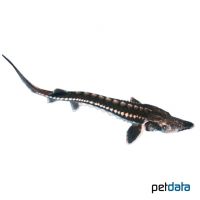Starry Sturgeon (Acipenser stellatus)
| Starry Sturgeon Acipenser stellatus | |
|---|---|
| Name | Starry Sturgeon |
| Name Lat. | Acipenser stellatus |
| Family | Sturgeons |
| Family lat. | Acipenseridae |
| Order | Sturgeons & Paddlefishes |
| Order lat. | Acipenseriformes |
| Origin | Eurasia |
| Habitat | Inland seas, tributaries |
| Diet | Carnivore |
| pH | 6.5-8.0 |
| Behavior | Peaceful |
| Keeping | Individual, group |
| Care Level | Experts only |
| Reproduction | Egg scatterer |
| Breeding | None reported |
| Life Span | 25-30 years |
| Protection | CITES Appendix II; EU Annex B |
| Metric Units | |
| Size | 130 cm |
| Temperature | 6-20 °C |
| Hardness | < 25 °dH |
| Aquarium | Pond |
| US Units | |
| Size | 51" |
| Temperature | 43-68 °F |
| Hardness | < 445 ppm |
| Aquarium | Pond |
Distribution and habitat
The distribution areas of the Sternhausen are the Black Sea, the Caspian Sea, the Sea of Azov and occasionally the Aral Sea and their tributaries. For spawning they migrate from saltwater to freshwater rivers. In the seas they live in the shallow coastal zones and estuaries of the rivers
Maintenance
They require very large ponds that are furnished with a soft substrate suitable for burrowing as well as round river pebbles and provide adequate swimming space. A light to moderate current is ideal
No ammonia, ammonium or nitrite should be detectable, and the nitrate value should not exceed 100 mg/l. To ensure the water quality and oxygen content, a filter adapted to the water volume should not be missing.
Diet
The agile fish have a large food requirement. In nature, they feed mainly on small fish and bottom-dwelling animals, such as crayfish and larvae. The food supply consists of a high-quality sinking dry food (granules, pellets) for sturgeons, supplemented with small crustaceans, fish spawn, insect larvae, fish and shellfish, which is also accepted without problems in frozen form, as well as earthworms, meal beetle larvae and snails.
Regular and varied feeding promotes health and increases resistance.
Behaviour and compatibility
They are peaceful fish that do not exhibit aggressive or incompatible behaviors and can be socialized well with other pond fish that are not too small.
In principle, only mutually compatible fish species with similar requirements for water quality and water temperature may be socialized.
Reproduction and breeding
The sexes are difficult to distinguish, the females appearing somewhat plumper than the males.
They undertake upstream spawning migrations (anadromous migratory fish), usually from April to June. Egg-laying occurs in the strong current of rivers on sandy or gravel bottoms. Males are sexually mature at 5-11 years, females at 8-13 years. Females embark on spawning migrations every 3-4 years and males every 2-3 years.
Species protection
Species protection: WA Appendix II; EU Appendix B. The proof of purchase is the required proof of origin for the animal. Please keep well!
Your pet store will be happy to provide you with further information.
Important
The water temperature should not exceed 20-22 °C
At temperatures below 8 °C the metabolism of the animals slows down and only little food is accepted. In spring, with rising temperatures, feeding can be slowly resumed. Feeding may also be necessary during prolonged warm periods in winter
The well-being of the fish should be checked regularly. A regular partial water change, according to the pond size is recommended, even if the pollutant load has not yet reached the upper limit. Sudden changes in water quality should be avoided. Newly introduced fish must be accustomed slowly to the water in the pond or aquarium. Further literature can be found in your pet store.
References
Text: petdata; Image: petdata
Source: BMELV (1998): Tierschutzgutachten - Haltung von Zierfischen (Süßwasser); RIEHL & BAENSCH (2004): Aquarien Atlas Bd. 3, Mergus Verlag; ENGELMANN (2005): Zootierhaltung - Tiere in menschlicher Obhut: Fische; Harri Deutsch Verlag
- Gemäß § 21 Abs. 5 Tierschutzgesetz idgF
